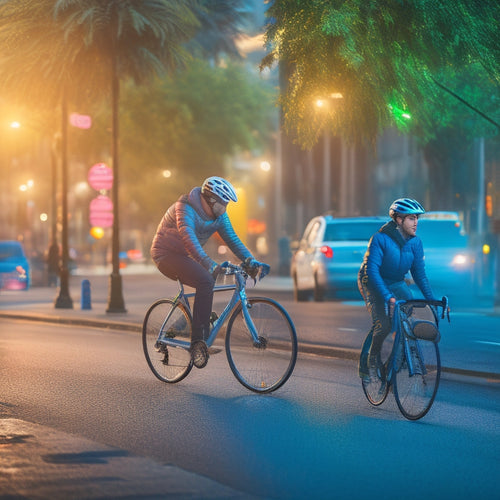
5 Smart Traffic Management Tips for Cyclist Safety
Share
To boost cyclist safety, you can implement five smart traffic management strategies. Design safe bike lanes with physical separation from traffic and clear markings. Install smart traffic signals that detect cyclists and adjust timings in real-time. Enhance visibility with reflective gear and nighttime illumination. Optimize road infrastructure by identifying high-traffic cycling corridors and segregating lanes. Finally, manage traffic flow dynamics by monitoring volume in real-time and adjusting routes to avoid congestion. By adopting these strategies, you'll be well on your way to creating a safer cycling environment - and there's more to explore to make a real impact.
Key Takeaways
• Prioritize physical separation of bike lanes from traffic using barriers or buffers to reduce conflicts and create a safer environment.
• Implement smart traffic signals that detect cyclists and adjust timings based on real-time monitoring to guarantee green lights when needed.
• Enhance cyclist visibility by up to 300% using reflective gear, ankle straps, arm bands, or clip-on reflectors, and nighttime illumination.
• Optimize road infrastructure by identifying high-traffic cycling corridors, designing segregated lanes, and implementing smart traffic signal control systems.
• Implement traffic flow dynamics management by monitoring traffic volume in real-time, adjusting routes to avoid congested areas, and maintaining a consistent pace.
Designing Safe Bike Lanes
When designing bike lanes, prioritize physical separation from traffic, using barriers or buffers to reduce conflicts between cyclists and motorists by up to 50%. By doing so, you'll create a safer environment for cyclists, allowing them to ride with confidence.
To further enhance safety, incorporate clear lane markings that define the bike lane and separate it from the main traffic flow. This visual cue helps both cyclists and motorists understand their respective spaces.
To take it a step further, incorporate bike-friendly curbs that provide a smooth shift between the bike lane and the sidewalk or adjacent road. These curbs should be designed with a gradual slope, allowing cyclists to easily navigate on and off the bike lane.
Implementing Smart Traffic Signals
By incorporating smart traffic signals that can detect and respond to cyclists' presence, you can further minimize the risk of accidents and create a more harmonious flow of traffic. These advanced systems use real-time monitoring to track cyclists' movements and adjust signal timings accordingly. This adaptive phasing guarantees that cyclists receive a green light when they need it, reducing the likelihood of conflicts with motorized vehicles.
Some key benefits of smart traffic signals include:
-
Improved safety: By detecting cyclists and pedestrians, smart signals can extend green light times to guarantee their safe passage.
-
Enhanced efficiency: Real-time monitoring enables signals to optimize traffic flow, reducing congestion and wait times.
-
Increased cyclist comfort: Smart signals can prioritize cyclists' needs, reducing frustration and anxiety caused by conflicting traffic signals.
- Data-driven insights: Smart signals provide valuable data on traffic patterns, helping urban planners optimize infrastructure for cyclists and other road users.
Enhancing Cyclist Visibility Measures
How can you increase your visibility on the road, making sure that motorists can see you and anticipate your next move? As a cyclist, it's vital to prioritize visibility, especially during low-light conditions. Invest in reflective gear, such as ankle straps, arm bands, or clip-on reflectors, to enhance your visibility by up to 300%. This simple yet effective measure can reduce your risk of being involved in an accident.
At night, incorporate nighttime illumination into your cycling routine. Use front and rear lights that meet local regulations, and consider adding additional lights to your pedals, seat post, or helmet. This won't only improve your visibility to motorists but also help you see the road ahead.
Don't rely on motorists to spot you - take control of your safety by being proactive about your visibility. By combining reflective gear and nighttime illumination, you'll greatly reduce your risk of being involved in an accident and ensure a safer cycling experience.
Optimizing Road Infrastructure Design
Designing roads with cyclists in mind can reduce accidents by up to 44%, making optimized infrastructure an essential aspect of smart traffic management.
As you plan and design roads, consider the following strategies to create a safer and more efficient cycling experience:
-
Corridor planning: Identify high-traffic cycling corridors and prioritize infrastructure upgrades in these areas to maximize safety benefits.
-
Network analysis: Use data-driven network analysis to identify critical intersections and road segments that require improved design and infrastructure.
-
Segregated cycling lanes: Design dedicated cycling lanes that are physically separated from motorized traffic to reduce conflicts and improve safety.
- Smart traffic signal control: Implement intelligent traffic signal control systems that prioritize cyclist safety and reduce congestion.
Managing Traffic Flow Dynamics
With 70% of cyclist fatalities occurring at intersections, effectively managing traffic flow dynamics is vital to reducing accidents and ensuring a smoother ride. As a cyclist, you know how intimidating it can be to navigate busy roads. To mitigate this, you need to understand how traffic volume affects your journey. By monitoring traffic volume in real-time, you can adjust your route accordingly, avoiding congested areas and minimizing your risk of accidents.
Implementing lane segregation is another essential aspect of managing traffic flow dynamics. By dedicating specific lanes to cyclists, you can reduce the risk of collisions with motor vehicles. This segregation also enables you to maintain a consistent pace, reducing the likelihood of sudden stops or swerves that can lead to accidents.
Frequently Asked Questions
Are Cyclists Required to Obey the Same Traffic Laws as Motorists?
As you ride, remember you're subject to the same traffic laws as motorists, so obeying signals and signs is a must - failure to comply can lead to fines in Traffic Courts, and in some cases, even impact your Cycling Licenses.
Can Cyclists Ride on Sidewalks in Urban Areas?
As you pedal through the concrete jungle, the sidewalk's siren call beckons, but beware: in most urban areas, you'll need to stick to the road, respecting pedestrian priority, and the careful balance of urban planning that puts feet first.
Are Bike Helmets Mandatory for Cyclists of All Ages?
You're wondering if bike helmets are mandatory for cyclists of all ages? In most places, yes, but there are helmet exemptions for certain ages or religions, and some cities allow helmet alternatives like turbans or scarves.
Can Cyclists Ride Against Traffic on One-Way Streets?
"Hey, ancient Greek philosopher, hop on your time-traveling bike! You can't ride against traffic on one-way streets, mate - it's a safety no-go. Instead, follow Lane Direction and Traffic Flow, cycling with the flow, not against it, for a safer, more harmonious ride."
Are Cyclists Allowed to Ride Side-By-Side With Friends?
When you ride with friends, you're practicing social cycling, and road etiquette dictates that you ride single-file, especially on narrow roads, allowing cars to pass safely, but on wide roads, you can ride side-by-side, enjoying the camaraderie.
Related Posts
-

What Electric Vehicle Owners Need for Home Energy
As an electric vehicle owner, you need to optimize your home energy system to guarantee efficient, sustainable, and c...
-

10 Essential Bike Lane Safety Features to Consider
You're designing a bike lane with safety in mind, and that's essential. The National Highway Traffic Safety Administr...
-

Eco-Friendly Car Battery Solutions Available Online
You can now shop online for eco-friendly car battery solutions that not only reduce your carbon footprint but also of...


